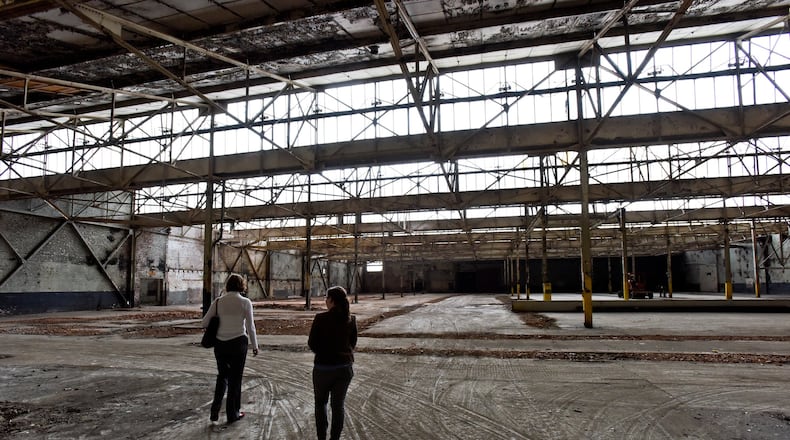MORE ONLINE
See video and a photo gallery of our tour of the former SMART Papers and Champion Paper mill only only at www.journal-news.com
An era ended in Hamilton in 2012 when two paper mills, each with a history that dated back more than a century, closed within months of each other. But new hopes are to return at least one of those mills back to life as a regional sports attraction.
First, Mohawk Fine Papers closed in January 2012 the Beckett Mill on Dayton Street. That was followed in March by SMART Papers, which wound down operations at the North B Street mill until the final shipping, cleaning and utility workers were let go.
“They might as well close Hamilton down,” Marcella Rommel, of Hamilton, told this reporter at a convenience store on Heaton Street at that time.
Three years later and under new ownership, plans are to revive the former SMART Papers property, the headquarters of Champion Paper before that, to include three sports venues: an indoor complex with courts and fields, a multi-purposes stadium for potentially professional league use, and a rowing center and boathouse.
Over $5 million has been invested on restoration work by current owner Green Reclamation Group, said Moses Glick, owner of the Pennsylvania-based firm. Green Reclamation bought in 2012 the part of the mill on the west side of North B Street from the city for $1, according to city records.
“To refurbish old buildings is more expensive than starting with new buildings,” Glick said.
When Green Reclamation started, the buildings were packed full of equipment, he said.
More than 600,000-square-feet of building space was demolished and in its place was enough room for the envisioned ballpark.
The remaining 500,000-square-feet of former factory floor has been gutted. Outdated lighting and plumbing fixtures have been removed, interior walls and beams that aren’t supporting the structure have been demolished, and holes and valleys in the floor are now being filled in, Glick said. Thousands was spent to remove asbestos, he said.
“You had some engineering decisions to be made on the structure of those buildings,” Glick said.
The site’s history will be integrated into the property’s future, but Glick made clear that he’s not spending thousands upon thousands to build a museum to Champion Paper.
Champion Paper made industrial history by introducing the first two-sided coated paper used for magazines.
This is the largest project Green Reclamation has undertaken, and the only one Glick intends to be a long-term investment, he said, highlighting the importance of the project.
“Believe me, there was a lot of ideas kicked around on the redevelopment of the property. Many, many ideas,” Glick said.
“But it all came back to the city of Hamilton. The best thing Green Reclamation could do for the city of Hamilton is put in an indoor sports park.”
“The further you are off the highway, the harder it is to get heavy manufacturing into a property,” he said.
During a tour May 14, the Journal-News saw signs of the bustling factory the place used to be, besides just the massive structure itself.
Machines and equipment have been removed, but rebar, pipes and other materials are stacked and sorted in piles. There are still filing cabinets containing paperwork, and a tool here and there. Safety and warning signs on the walls tell workers not to enter designated areas — “Positively no admittance” one sign reads — and a sticker on a bulletin board still hanging on a wall reads “Machinists are bold metalists.”
There are also signs of age. Old window panes laced with chicken wire are broken. And in some places, the caved-in roof is leaking. There’s graffiti on some walls, and the red paint is peeling on the multi-story tall fire doors that still rely on weights and balances to open and close.
Demolition work overall is now about 85 percent to 90 percent complete, Glick said. And as work continues, one of the next steps is to replace the roof, he said.
Meanwhile, Glick and a group of local stakeholders — including his hired project manager Frances Mennone, a board member of The Great Miami Rowing Center; local architect Mike Dingeldein of Community Design Alliance; and community volunteer Jim Fitton — are beginning fundraising efforts and working to build support throughout Butler County for the transformation plans.
“We want the best sports facility that we can build, the best spaces, the best flooring, to make it a sports park. We will be integrating a lot of the old stuff,” Glick said.
While Glick’s firm is tackling the mill property on the west side of B street, mill property on the east side of B Street is still owned by the city.
About the Author
